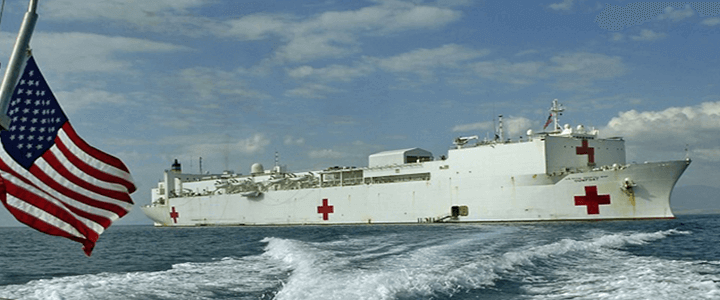The highly publicized U.S. Navy hospital ships didn’t provide much comfort to those in need this week. The USNS Comfort, which was deployed to New York City, had only treated 27 patients as of Saturday, whilst its sister ship the USNS Mercy, which arrived in Los Angeles last week has since treated only 18 patients. Neither vessel was actually sent to the respective cities to treat those infected with COVID-19, but rather to alleviate some of the pressure from other hospitals that are struggling to handle the influx of coronavirus patients.
Each of the ships are converted supertankers that and are equipped with 12 operating rooms and have up to 1,000 beds. Both ships offer the services of a hospital including a CAT scanner, two oxygen-producing plants, digital radiology and even optometry labs. The ships also have the staff of a large city hospital – up to 1,200 personnel that includes doctors, nurses and medical specialists. Each is so big that each could be equal in size to the fourth-largest hospital in the country.
While the ships arrived sooner than expected, so far there hasn’t been the demand in patients.
“We’re here in support of FEMA in the state of California so we’re ready to answer whatever the demand signal is,” U.S. Navy Capt. John Rotruck, the commanding officer of the USNS Mercy, told Pentagon reporters via telephone this week. “And if that demand signal ramps up, we’ll certainly be ready to accommodate that.”
President Donald Trump left a nine-day sequester in the White House last week and traveled to Norfolk, VA to see of the USNS Comfort. At the time he said the hospital ship would play a critical role in New York City, and its arrival on Monday was cheered. Yet days later this ship has mostly sat idle.
This has been mostly due to what The New York Times suggested was “a tangle of military protocols and bureaucratic hurdles,” which “has prevented the Comfort from accepting many patients at all.” One issue is that people infected with COVID-19 aren’t allowed on board. In addition, ambulances cannot take patients directly to the Navy hospital ship.
Patients must first go to a city hospital, undergo a lengthy evaluation – which includes testing for the virus – and then be picked up and taken to the ship. It has also been suggested that there isn’t currently a high volume of non-COVID-19 patients. There are fewer accidents, as most New Yorkers have isolated themselves.
The ships, with their wide-open treatment bays, are not properly configured to treat patients with the highly transmissible coronavirus.
Given this situation in New York City it possible that the USNS Comfort could be deployed to another coastal city should the pandemic grow worse. Both USNS Comfort and USNS Mercy have side ports to take patients at sea, as well as helicopter decks for air transport.
Almost Retired
What is also worth noting is that just two years ago the United States Navy had pushed to retire the twin hospital ships. The 900-foot long ships, which each displace around 69,360 tons with a full load, were acquired by the Navy in 1986 and 1987, and as noted, each was a converted oil tank.
The ships were designed to handle combat casualties during operations in wartime, but have seen more service in humanitarian roles. USNS Comfort took part in the post-9/11 recovery efforts in New York City and in 2005 was sent to New Orleans to help in the aftermath of Hurricane Katrina.
Despite the good the ships have done, and could do, the Navy had called for putting one or both the ships in mothballs in its 2019 budget, citing the high costs of operating and maintaining the ships. The Navy has also cited the fact that the size is a problem – the ships are too big for a more distributed maritime operations construct, a fact noted by U.S. Navy Vice Admiral William Merz, then Deputy Chief of Naval Operations for Warfare Systems to members of Congress in 2018.
That was also not the first time the Navy wanted to retire the massive hospital ships. In 2004, now-retired U.S. Navy Vice Admiral Michael Cowen, then Surgeon General of the United States Navy, noted that the ships were designed in the 1970s and built in 1980s, and are obsolete in the 21st century.
Lawmakers haven’t seen it that way, and instead have pointed to the humanitarian missions that the ships provide, as well as how each serves as to project “soft power” to advance American interests throughout the world.
While the Navy had wanted to move to the Common Hull Auxiliary Multi-Mission Platform (CHAMP) program, which would include a fleet of smaller ships the program was canceled last year. As a result the USNS Comfort and USNS Mercy will remain the Navy’s massive floating hospitals.




